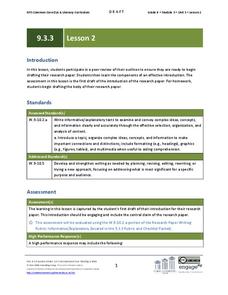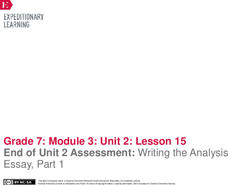Pace University
Grades 7-8 Solving Equations
Create a similar blueprint. The differentiated lesson has pupils work in teams to create a brochure, scale model, or blueprint of a selected house with some minor changes. Once finished, team members present their final projects to the...
Curated OER
Using Social Studies in Five Shared Reading Lessons: Geography
After several short 15-minute mini-lessons, your learners will gain an understanding of the characteristics of a non-fiction text. Using the book Map It by Elspeth Leacock, your class will become acquainted with non-fiction terms such as...
EngageNY
Analyzing the Structure and Content of an Essay to Inform
Outlines are a great asset to essay planning. Scholars read and analyze a model essay about the importance of daily reading and consider how it would look in an outline format. Next, they outline their own informative essays about rules...
EngageNY
Grade 9 ELA Module 3, Unit 3, Lesson 2
After a peer review of their outlines, class members examine a model of an effective, engaging introduction and then craft the first draft of the introduction to their research paper.
EngageNY
Clarifying Thinking on Water Management: Revisiting the Gallery Walk
One, two, three, go! Scholars gather in triads and number themselves one to three. Each number is responsible for sharing a section of the map homework completed the night before as learners discuss domain-specific vocabulary terms using...
Curated OER
Outline It!
Fourth graders investigate how outlining can aid in comprehending text. In this reading comprehension instructional activity, 4th graders outline an article they read in groups of two. Students take turns reading the article, identifying...
Curated OER
Science Lessons for Grade 7
Seventh graders construct a food chain based on pictures shown on the board. In this biology lesson, 7th graders describe the motion of particles as energy is changed. They explain how pH changes during neutralization.
Curated OER
Exploring Biomes Lesson 5: You Need a Vacation
In cooperative groups, emerging ecologists research assigned biomes found in Arizona. Combining photos and facts, they use PowerPoint to produce a fully automated commercial that lasts 45 seconds. In addition to the lesson outline,...
Curated OER
How To Write a Social Studies Outline
One of the keys to success in school is organization. This resource leads learners through the process of creating an outline for a chapter from a social studies text. In addition, they review facts they have learned in their class...
California Department of Education
What's Next?
Let their futures take flight! The sixth and final installment in a series of career and college readiness lesson plans pulls it all together for graduation-bound seniors. Individuals comb through their action plans and describe the...
Civil War Trust
Gettysburg Address
The Gettysburg Address may have been four score and seven years ago, but its message is still as relevant today. Young historians explore the context of the famous speech, as well as its central theme and argument, before discussing the...
EngageNY
How Do Dilations Map Lines, Rays, and Circles?
Applying a learned technique to a new type of problem is an important skill in mathematics. The lesson asks scholars to apply their understanding to analyze dilations of different figures. They make conjectures and conclusions to...
Redefining Progress
Have and Have-Not
Is there a correlation between a country's wealth and the extent of its ecological footprint? What exactly constitutes an ecological footprint, and how does one country stack up against the rest? This is a unique lesson to incorporate...
Curated OER
Outline and Shine
Seventh graders read and discuss a short story. They complete an outline of the story. They pair and share to evaluate each other's outlines.
NOAA
Biological Oceanographic Investigations – I, Robot, Can Do That!
How do you decide the best person for each job? Would it be easier if you didn't have to consider their feelings? The lesson begins with a discussion of underwater robots. Then groups research one of these robots and present their...
Illustrative Mathematics
Grandfather Tang's Story
It's amazing the complex figures that can be made using only a few simple shapes. Following a class reading of the children's book Grandfather Tang's Story by Ann Tompert, young mathematicians use sets of tangrams to create models of the...
Constitutional Rights Foundation
Driver’s Licenses And Unauthorized Immigrants
Should driver's licenses be granted to unauthorized immigrants? That is the question class members grapple with in a lesson that asks them to first read a fact sheet that details the arguments for and against licensing unauthorized...
Curated OER
Seven Steps for Writing an Academic Essay
Young scholars brainstorm ideas for a teacher selected writing topic. They demonstrate seven steps for writing an academic essay. They jot down words or phrases using different colored pens. They write a thesis statement and create an...
EngageNY
Mid-Unit 3 Assessment, Part II: Organizing Notes for a Public Speech
It's all a matter of opinion! Pupils take Part II of the mid-unit assessment, in which they continue organizing their notes in preparation for writing an opinion speech. Using the resource, they add reasons, evidence, and a concluding...
EngageNY
Mid-Unit 3 Assessment, Part I: Short Constructed Response and Organizing Notes for a Public Speech
It's time to put pen to paper. Scholars complete the first part of the mid-unit 3 assessment, writing a short constructed response about international aid following a natural disaster. Next, pupils use informational texts and note...
Shodor Education Foundation
Triangle Area
While the lesson focuses on right triangles, this activity offers a great way to practice the area of all triangles through an interactive webpage. The activity begins with the class taking a square paper and cutting in in half; can they...
EngageNY
Summarizing a Data Distribution by Describing Center, Variability, and Shape
Put those numbers to work by completing a statistical study! Pupils finish the last two steps in a statistical study by summarizing data with displays and numerical summaries. Individuals use the summaries to answer the statistical...
EngageNY
End of Unit 2 Assessment: Writing the Analysis Essay, Part 1
1,2,3,4 score! Writers use the grading rubric to score the model essay. After comparing and discussing their scorings, the individuals begin the end-of-unit assessment.
Curated OER
Take Note2!
Students practice the note-taking skills of Pocket Note Taking, Outlining, and 2 column note taking. They use pocket notes, outlining, and/or two-column notes to summarize information taken from web sites or other sources. Afterward,...

























